300 yard and 225 yard groups … Long with pics.
Posted: Mon Nov 29, 2010 3:05 pm
300 yard and 225 yard groups … an exercise in extreme range air rifle FAC bench rested shooting..
The aims of this exercise were to determine pellet stability from inspection of pellet holes through a double layer thick cardboard target; get an indication of penetration at extreme range; and to hopefully get an indication of grouping ability of the rig at 300 yards in "best conditions".
Some may recall my reports of extreme range shooting with the .25 cal BSA John Bowkett Hornet which has proven itself as a consistent sub inch shooter at 100 yards and has shot sub MOA out to 150 yd and a whisker over it at 200 yd. Posts down the pages.
Two weeks ago I traveled to my friend Rob Moffitt's farm and range in The Snowy Mountains of NSW. It is a five and a half hours' drive to there and the weekend proved to be damp with showers on and off but with some very good calm spells.
We arrived before midnight Friday night. Saturday morning I set up firstly at 50 yards and shot a few groups before setting a 60 litre oil drum at 225 yards laser measured in the meadow near a tiny stream.
One cannot place too much importance to having a clean air rifle barrel so as is my practice, I put a dry pull-through through the barrel once. Unlike using cleaning agents or oil, this removes any lead dust etc., without the requirement to shoot a number of pellets before the rifle re-settles for precision grouping.
It was then just a waiting game for the conditions I needed for best shooting.
The sight was zeroed for a 220 yard zero. To save questions about that:
The sight is a Bushnell 6500 Elite 30 mm tube 4-16X set at 16X. It has an 80 MOA turret elevation range which allows for 15 feet of scope elevation at 220 yards. The rear mount is also shimmed for another approximately 30 MOA. Depending upon MV setting this combination allows me to zero the rifle to 220+ yards without any holdover and without using the absolute extremes of the internal adjustments.
In this instance I had the scope zeroed for 220 yards which coincidentally requires 220 clicks from a 50 yd zero.
When my two wind flags showed stable air, I fired just three shots before the flags indicated a change. We have a rustic but very solid shooting bench from which to shoot:
Here is the 3 shot group which was aimed at the centre top edge of the drum. It measures 0.917 MOA; 2.16 inches; 54.8 mm CTC. At 225 yd 1 MOA is 2.355 inches. The drop at this range is a tad over one inch per yard so the group formed 6 inches below the POA.
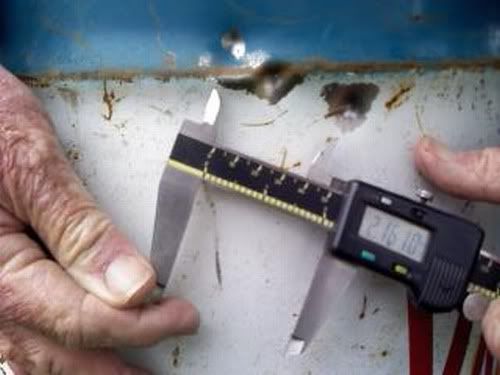
Here are two pics of one of the .25 JSB King pellets retrieved from a few yards in front of the drum. :
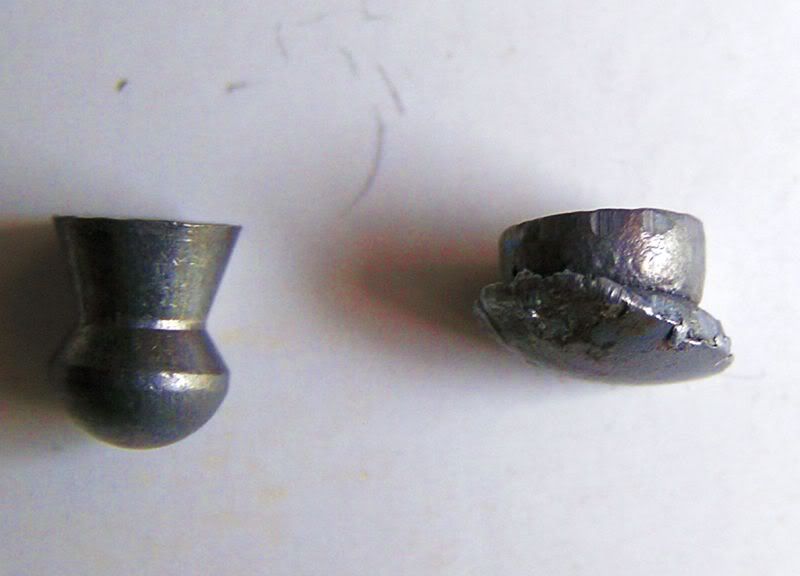
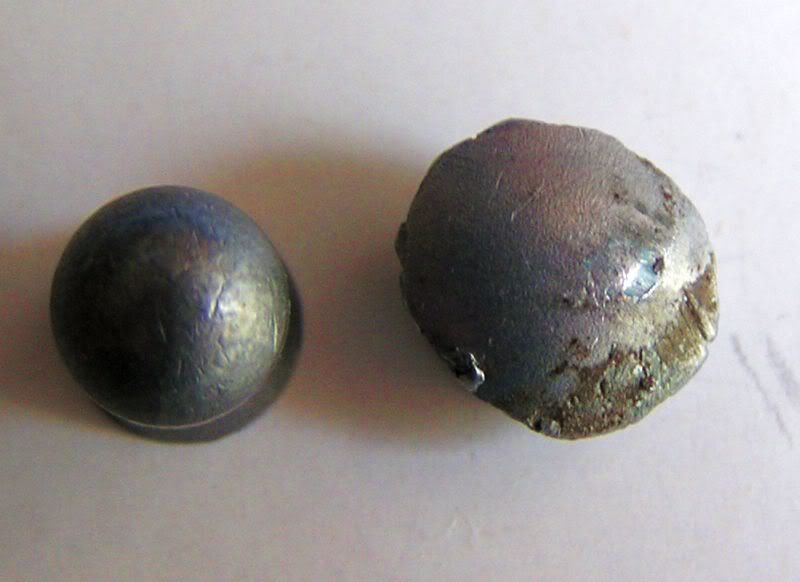
For my 300 yard test Rob had acquired a large cardboard box which, when squashed flat, squared out at about four foot square to make a double walled target with a thickness of 2 x ½ inch = 1 inch total.
I carried this to the lasered 300 yard mark and we erected it with two steel star fence posts and a light sledge hammer. The logistics of this sort of test shooting requires some time and effort and a little walking and carrying of tools too.
With the target set up I consulted my ballistic table, which indicated a drop of a tad over 12 feet from the 220 yard zero .
For those who like to play with Oooh Aaah figures, the drop from a horizontal barrel would be 32 feet. However as we never shoot that way that is not a useful statistic . ... If the rifle was actually zeroed for 300 yards the apex of the trajectory would be 10 feet above the sight line. As my sight set-up could presently only zero to 220 yards I had to aim-over the required 12 feet. Note that when the pellets were passing the 220 yards they would be well above a line from rifle to target. Rob found a suitable length of copper pipe for me to carry down ( walking is good for folks my age ) and with which to locate an aiming mark in the overhanging tree directly above the cardboard target. ... No bullseye was required because the purpose was to establish a group with no intention of hitting a mark other than the middle (hopefully) of the cardboard.
Photo of the range with 300 yard target centre top just under the trees.. The creek is 250 yd. The oil drum is this side the creek (hard to see, cell phones have their limitations). The target in the foreground is 50 yards.
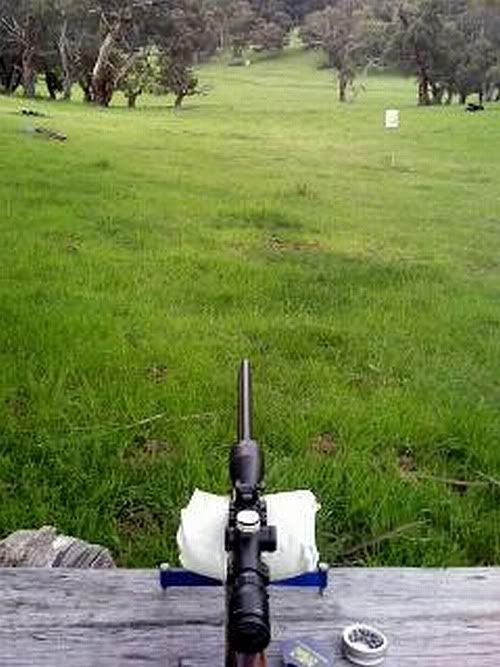
The waiting game at the bench was protracted but eventually the conditions seemed settled with the flags hanging slack and the group was carefully shot.

The group measures 2.27 MOA, or 7.13 inches CTC ; or 4.8 in vertical and 5.2 in horizontal for those who prefer that method. There are four shot holes in 1.22 MOA or 3.82 inches CTC. ... 1 MOA at 300 yards is 3.141 inches.
This is not a cherry picked group from many groups. ... It was the only one shot.
This rifle and JSB .25 King pellets have inherent grouping ability that is well beyond what most would credit to a small bore air rifle .
Stats: The PCP BSA .25 Hornet has a 23 ½ inch barrel presently shooting 25.4 gr JSB Exacts at 880 fps, 44 fpe with the 25.4 gr JSB Exact Kings.
At 4040 ft altitude the JSB pellet BC is an average 0.043 over the first 200 yards shot with this rifle and pellets and measured by me over a chronograph at 50, 100 and 200 yards . Bushnell scope is as indicated further up. My trajectory chart is specific to this rifle and pellets and is a modification of Dave Eade's Chairgun programme. He wrote the modified programme specifically for me using my data which takes into account the progressive improvement in BC over the first 200 yards.
This was a more controlled effort than my last one earlier in the year at my own farm and it answered a number of questions.
My previous suspicions of loss of stability of the pellets at this range were unfounded, at least in these stable air conditions.
All pellets made normal POI holes in the cardboard indicative of stability and with no evidence of keyholing. Furthermore the entry holes in the second layer of cardboard were also normal PsOI, thus the first strike penetration had not upset the pellets even though there was a gap of a few inches between the two layers of cardboard..
See pic. which shows exit holes in the back of the second wall of cardboard. The cardboard's thickness is shown at the top.
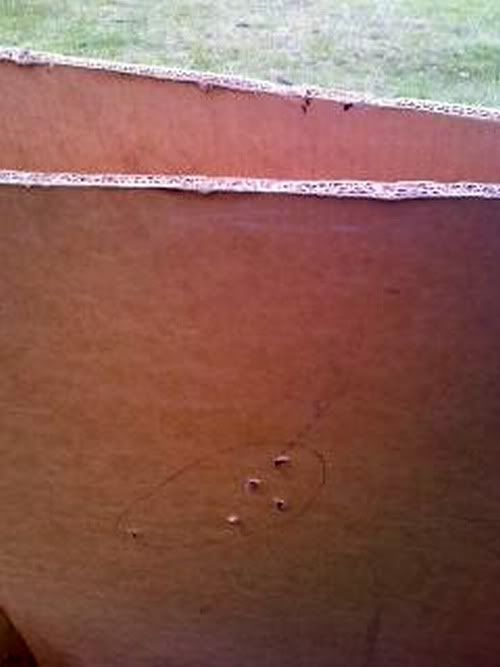
Penetration depends upon momentum. These pellets obviously still have serious penetration at the 300 yard range. According to Chairgun they retain 44 % of initial momentum or 0.022 lbf.s at 300 yd of the 0.050 lbf.s muzzle momentum . All pellets went through the two layers of the ½ inch cardboard composed of 8 layers of dense cardboard and 6 corrugated layers, 14 in all. This cardboard box was for containing heavy machinery.
The impact was quite audible in the calm mountain air, even to my dull ears. The large solid cardboard area probably amplified the sound. The time lapse between trigger break and the returning sound I counted as 0, 1, 2, 3. My Chairgun programme indicates a TOF of 1.6 seconds plus say 0.80 sec for the sound to return.
We did some work, picked field mushrooms to have with bacon for breakfast, hoed down some thistles and shot a few very healthy rabbits for eating. A very satisfactory weekend.
Kind regards, Yrrah.
The aims of this exercise were to determine pellet stability from inspection of pellet holes through a double layer thick cardboard target; get an indication of penetration at extreme range; and to hopefully get an indication of grouping ability of the rig at 300 yards in "best conditions".
Some may recall my reports of extreme range shooting with the .25 cal BSA John Bowkett Hornet which has proven itself as a consistent sub inch shooter at 100 yards and has shot sub MOA out to 150 yd and a whisker over it at 200 yd. Posts down the pages.
Two weeks ago I traveled to my friend Rob Moffitt's farm and range in The Snowy Mountains of NSW. It is a five and a half hours' drive to there and the weekend proved to be damp with showers on and off but with some very good calm spells.
We arrived before midnight Friday night. Saturday morning I set up firstly at 50 yards and shot a few groups before setting a 60 litre oil drum at 225 yards laser measured in the meadow near a tiny stream.
One cannot place too much importance to having a clean air rifle barrel so as is my practice, I put a dry pull-through through the barrel once. Unlike using cleaning agents or oil, this removes any lead dust etc., without the requirement to shoot a number of pellets before the rifle re-settles for precision grouping.
It was then just a waiting game for the conditions I needed for best shooting.
The sight was zeroed for a 220 yard zero. To save questions about that:
The sight is a Bushnell 6500 Elite 30 mm tube 4-16X set at 16X. It has an 80 MOA turret elevation range which allows for 15 feet of scope elevation at 220 yards. The rear mount is also shimmed for another approximately 30 MOA. Depending upon MV setting this combination allows me to zero the rifle to 220+ yards without any holdover and without using the absolute extremes of the internal adjustments.
In this instance I had the scope zeroed for 220 yards which coincidentally requires 220 clicks from a 50 yd zero.
When my two wind flags showed stable air, I fired just three shots before the flags indicated a change. We have a rustic but very solid shooting bench from which to shoot:
Here is the 3 shot group which was aimed at the centre top edge of the drum. It measures 0.917 MOA; 2.16 inches; 54.8 mm CTC. At 225 yd 1 MOA is 2.355 inches. The drop at this range is a tad over one inch per yard so the group formed 6 inches below the POA.

Here are two pics of one of the .25 JSB King pellets retrieved from a few yards in front of the drum. :


For my 300 yard test Rob had acquired a large cardboard box which, when squashed flat, squared out at about four foot square to make a double walled target with a thickness of 2 x ½ inch = 1 inch total.
I carried this to the lasered 300 yard mark and we erected it with two steel star fence posts and a light sledge hammer. The logistics of this sort of test shooting requires some time and effort and a little walking and carrying of tools too.
With the target set up I consulted my ballistic table, which indicated a drop of a tad over 12 feet from the 220 yard zero .
For those who like to play with Oooh Aaah figures, the drop from a horizontal barrel would be 32 feet. However as we never shoot that way that is not a useful statistic . ... If the rifle was actually zeroed for 300 yards the apex of the trajectory would be 10 feet above the sight line. As my sight set-up could presently only zero to 220 yards I had to aim-over the required 12 feet. Note that when the pellets were passing the 220 yards they would be well above a line from rifle to target. Rob found a suitable length of copper pipe for me to carry down ( walking is good for folks my age ) and with which to locate an aiming mark in the overhanging tree directly above the cardboard target. ... No bullseye was required because the purpose was to establish a group with no intention of hitting a mark other than the middle (hopefully) of the cardboard.
Photo of the range with 300 yard target centre top just under the trees.. The creek is 250 yd. The oil drum is this side the creek (hard to see, cell phones have their limitations). The target in the foreground is 50 yards.

The waiting game at the bench was protracted but eventually the conditions seemed settled with the flags hanging slack and the group was carefully shot.

The group measures 2.27 MOA, or 7.13 inches CTC ; or 4.8 in vertical and 5.2 in horizontal for those who prefer that method. There are four shot holes in 1.22 MOA or 3.82 inches CTC. ... 1 MOA at 300 yards is 3.141 inches.
This is not a cherry picked group from many groups. ... It was the only one shot.
This rifle and JSB .25 King pellets have inherent grouping ability that is well beyond what most would credit to a small bore air rifle .
Stats: The PCP BSA .25 Hornet has a 23 ½ inch barrel presently shooting 25.4 gr JSB Exacts at 880 fps, 44 fpe with the 25.4 gr JSB Exact Kings.
At 4040 ft altitude the JSB pellet BC is an average 0.043 over the first 200 yards shot with this rifle and pellets and measured by me over a chronograph at 50, 100 and 200 yards . Bushnell scope is as indicated further up. My trajectory chart is specific to this rifle and pellets and is a modification of Dave Eade's Chairgun programme. He wrote the modified programme specifically for me using my data which takes into account the progressive improvement in BC over the first 200 yards.
This was a more controlled effort than my last one earlier in the year at my own farm and it answered a number of questions.
My previous suspicions of loss of stability of the pellets at this range were unfounded, at least in these stable air conditions.
All pellets made normal POI holes in the cardboard indicative of stability and with no evidence of keyholing. Furthermore the entry holes in the second layer of cardboard were also normal PsOI, thus the first strike penetration had not upset the pellets even though there was a gap of a few inches between the two layers of cardboard..
See pic. which shows exit holes in the back of the second wall of cardboard. The cardboard's thickness is shown at the top.

Penetration depends upon momentum. These pellets obviously still have serious penetration at the 300 yard range. According to Chairgun they retain 44 % of initial momentum or 0.022 lbf.s at 300 yd of the 0.050 lbf.s muzzle momentum . All pellets went through the two layers of the ½ inch cardboard composed of 8 layers of dense cardboard and 6 corrugated layers, 14 in all. This cardboard box was for containing heavy machinery.
The impact was quite audible in the calm mountain air, even to my dull ears. The large solid cardboard area probably amplified the sound. The time lapse between trigger break and the returning sound I counted as 0, 1, 2, 3. My Chairgun programme indicates a TOF of 1.6 seconds plus say 0.80 sec for the sound to return.
We did some work, picked field mushrooms to have with bacon for breakfast, hoed down some thistles and shot a few very healthy rabbits for eating. A very satisfactory weekend.
Kind regards, Yrrah.